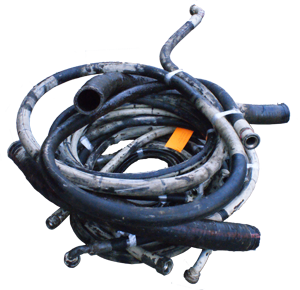Scheduled hydraulic hose replacement saves time and money

 All hydraulic hoses will fail; it’s only a matter of time. It might seem logical to replace hoses only when they fail, but not using a preventative maintenance program can create serious problems.
All hydraulic hoses will fail; it’s only a matter of time. It might seem logical to replace hoses only when they fail, but not using a preventative maintenance program can create serious problems.
A breakdown is always more expensive than scheduled maintenance. Disadvantages of breakdowns:
- Special ordering
- Higher shipping fees to rush the order
- Broken down equipment & workers will sit idle, resulting in lost production
- Labor costs could increase because of overtime hours
- Loss of hydraulic oil & environmental cleanup costs
- Damage to equipment from failing hose
A failed hose can result in serious injury and even death
- Hot hydraulic oil can burn personnel
- Spilled oil create slip and fall hazards and creates a fire danger
- Pinhole leaks in a hydraulic hose can cause oil injection injuries which can result in loss of limb or even your life
With all the potential problems that can occur from hose failure, it is important to understand why they fail in order to prevent these problems.
Hoses age even when stored
Most hydraulic hoses are made of a rubber compound that naturally ages. Everything from temperature, humidity, sunlight, oils, solvents, dirt, corrosive liquids, salt water, ultraviolet light, bugs, rodents and radioactive materials can adversely affect a hoses shelf life.
Installing an unsuitable hydraulic assembly is another reason hoses fail
When selecting hydraulic hose assemblies, there are many things one must take into consideration:
- Suitability for your particular application
- Size of the hose - circumference and length
- Type of fluid - hydraulic oil, gas, water or steam
- Fluid pressure
- Temperature
- Length of exposure to fluid
- Your choice of hose fittings (hose ends); be sure to choose correctly
Improper hose assembly installation can also be a factor
Machines move and the parts need to be able to shift with that motion. Hose assemblies should allow for the movement of parts without being twisted, pulled or bent tighter than allowed by the minimum bend radius. A hose assembly should also only be installed by well-trained personnel.
Seals in fittings and adapters can also cause your hose assembly to fail
Seals can harden, crack and deteriorate; they are just as vulnerable to the wear and tear of mother-nature as the hose itself.
Be it man or mother-nature who is to blame, all of these potential problems can be avoided through consistent, regular maintenance checks of your hydraulic system. Doing so will save time, money, and possibly a life.
Posted by Tari Clair-Parsons




